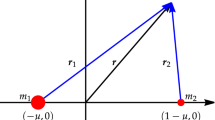Abstract
We consider a restricted three-body problem consisting of two positive equal masses m 1 = m 2 moving, under the mutual gravitational attraction, in a collision orbit and a third infinitesimal mass m 3 moving in the plane P perpendicular to the line joining m 1 and m 2. The plane P is assumed to pass through the center of mass of m 1 and m 2. Since the motion of m 1 and m 2 is not affected by m 3, from the symmetry of the configuration it is clear that m 3 remains in the plane P and the three masses are at the vertices of an isosceles triangle for all time. The restricted planar isosceles three-body problem describes the motion of m 3 when its angular momentum is different from zero and the motion of m 1 and m 2 is not periodic. Our main result is the characterization of the global flow of this problem.
Similar content being viewed by others
References
Alvarez M., Cors J., Delgado J.: On final evolutions in the restricted planar parabolic three-body problem. Celest. Mech. Dyn. Astron. 95, 173–200 (2006)
Conley, C.: Isolated invariant sets and the Morse Theory. Conference Board of the Mathematical Sciences, Regional Conference Series in Mathematics, vol. 38 (1976)
Cors J., Llibre J.: The global flow of the hyperbolic restricted three-body problem. Arch. Rational Mech. Anal. 131, 335–358 (1995)
Cors J., Llibre J.: Qualitative study of the parabolic collision restricted three-body problem. Contemp. Math. 188, 1–19 (1996a)
Cors J., Llibre J.: Qualitative study of the hyperbolic collision restricted three-body problem. Nonlinearity 9, 1299–1316 (1996b)
Cors J., Llibre J.: The global flow of the parabolic restricted three-body problem. Celest. Mech. Dyn. Astron. 90, 13–33 (2004)
Faintich M.: Application of the restricted hyperbolic three-body problem to a star–sun–comet system. Celest. Mech. Dyn. Astron. 6, 22–26 (1972)
Lacomba E., Llibre J.: On the dynamics and topology of the elliptic rectilinear restricted 3-body problem. Celest. Mech. Dyn. Astron. 77, 1–15 (2000)
Llibre J., Pasca D.: Periodic orbits of the planar collision restricted 3-body problem. Celest. Mech. Dyn. Astron. 96, 19–29 (2006)
Llibre J., Pasca D.: Erratum to: “periodic orbits of the planar collision restricted 3-body problem”. Celest. Mech. Dyn. Astron. 98, 217 (2007)
Meyer K., Wang Q.: Global phase structure of the restricted isosceles three-body problem with positive energy. Trans. Am. Math. Soc. 338(1), 311–336 (1993)
Moser J.: Stable and random motions in dynamical systems. Annals Mathematics Studies, vol. 77. Princeton University Press, Princeton, NJ (1973)
Puel F.: Numerical study of the rectilinear isosceles restricted problem. Celest. Mech. Dyn. Astron. 20, 105–123 (1979)
Sotomayor, J.: Lições de Equações Diferenciais Ordinárias. IMPA, Río de Janeiro (1979)
Vidal C., Gómez P.: An extension of the Poincaré compactification and a geometric interpretation. Proyecciones (Antofagasta) 22(3), 161–180 (2003)
Wang Q.: Qualitative study of n-body problem: untized momentum transformation and its application restricted isoceles three-body problem with positive energy. In: Bhatnagar, K.B. (eds) Space Dynamics and Celestial Mechanics, pp. 61–69. D. Reidel, Dordrecht (1986)
Wintner A.: The Analytical Foundations of Celestial Mechanics. Princeton University Press, Princeton (1947)
Author information
Authors and Affiliations
Corresponding author
Rights and permissions
About this article
Cite this article
Cors, J.M., Castilho, C. & Vidal, C. The restricted planar isosceles three-body problem with non-negative energy. Celest Mech Dyn Astr 103, 163–177 (2009). https://doi.org/10.1007/s10569-008-9178-x
Received:
Revised:
Accepted:
Published:
Issue Date:
DOI: https://doi.org/10.1007/s10569-008-9178-x




